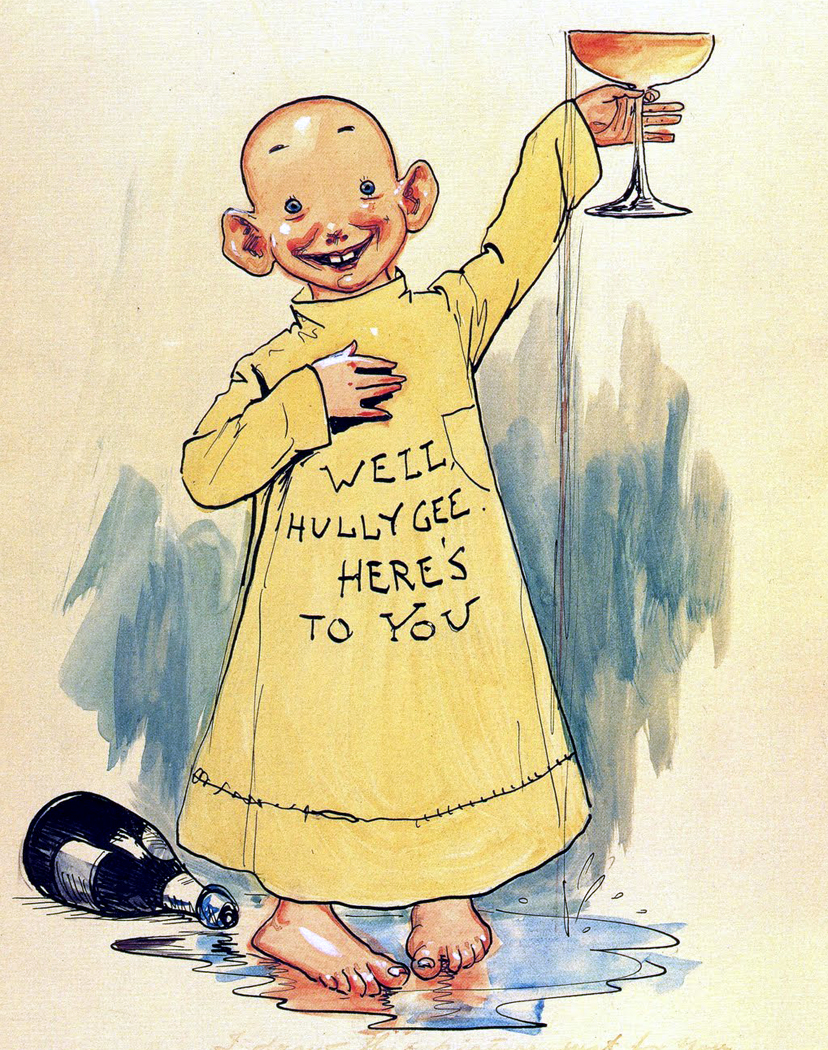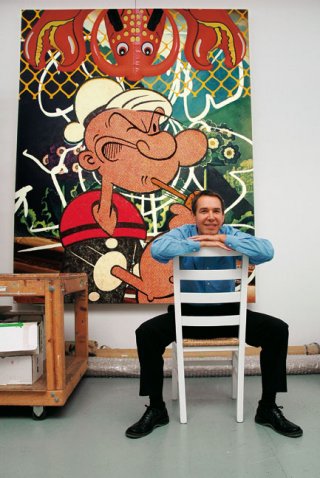By JAMIN BROPHY-WARREN
March 8, 2008.
Paul Pope usually draws costumes for superheroes. Now he's designing clothes for real people.
The 37-year-old artist has inked works for both Marvel and DC Comics. Last year, he won two Eisner Awards (the comic equivalent of an Oscar) for his work on "Batman: Year 100," a portrait of the Dark Knight in 2039. Revered comics creator Frank Miller calls Mr. Pope's work "brilliantly sloppy."
 Paul Pope, an award-winning cartoonist known for his gritty style, looks through some of his work.
Paul Pope, an award-winning cartoonist known for his gritty style, looks through some of his work.
Recently, Mr. Pope has set his sights on another creative arena: fashion. Last year, Diesel, an Italian fashion company, hired him to design silk-screens and window displays for its Los Angeles store. Also last year, Mr. Pope took on his biggest fashion project: DKNY, the New York fashion company started by Donna Karan, tapped him to design his own line for the DKNY Jeans brand, bringing his dark graphic work to pants, hoodies and T-shirts. Last week, the final samples of his work arrived at the company's headquarters in New York. The line debuts this fall.
Kevin Monogue, president of DKNY Jeans, says the cartoonist's art strikes a chord with the company's target customers: fashion-forward urban professionals.
Cartoonists like Mr. Pope have become major players in the entertainment world. Marjane Satrapi, author of "Persepolis," co-directed the Oscar-nominated movie based on her graphic novel. Mr. Miller, author of the comics "Sin City" and "300" (both made into hit movies), is directing the film "The Spirit." And writer Brian K. Vaughan rode the popularity of his "Y: The Last Man" and "Ex Machina" comic books into an executive story-editor position for ABC's "Lost."
Joss Whedon, writer of the TV show "Buffy the Vampire Slayer," which is now a best-selling comic, says that comic artists are a great source of ideas. "To put it in movie terms, he's your co-director, actor, editor, and costume designer. He makes everything at once," says Mr. Whedon.
Mr. Pope has been in demand by a wide range of companies. Industrial Light and Magic flew him to San Francisco to teach its staff the finer points of creating fictional worlds. The popular vinyl toy maker Kidrobot tapped Mr. Pope to create a line for the company. He also served as a consultant for the animated film adaptation of Michael Chabon's Pulitzer-winning novel "The Amazing Adventures of Kavalier & Clay."

Mr Pope para DKNY
Fellow cartoonists call Mr. Pope the "Jim Morrison of comics," for his brooding material and his ragged fashion sense. In his comics, his brush strokes are lush and unruly, and evoke Japanese calligraphy. His images are typically gritty and dystopian, but underlined with a dark beauty. At last year's San Diego Comic-Con, Mr. Pope was mobbed by hundreds of fans demanding signatures on their sketchbooks and the occasional body part. Mr. Pope regularly turns material in late, but collaborators endure the tardiness because "it's damn well worth it," one former editor says.
Artistic Inspiration
At the viewing of his line for DKNY last week, Mr. Pope arrived fashionably late, finally entering adorned in a black velvet jacket and boot-cut jeans. DKNY's Mr. Monogue waited for more than a half hour. Surrounded by mannequins wearing his clothing, Mr. Pope laced his fingers along the inside of the items. It was the first time Mr. Pope had seen the finished pieces on a human shape. He lingered over one of his favorite pieces: a jacket with a multi-panel comic he authored splayed across the inside. The comic was an abstract piece about love in outer space. "We looked at a lot of Mapplethorpe for this one," he says, referring to Robert Mapplethorpe, the photographer known for his stark, often erotic black-and-white work.
Mr. Pope often draws inspiration from artists outside his field, such as photographers, painters and musicians. He thrives at night, taking in jazz at a bar around the corner of his SoHo area apartment. He walks with a low gait and a long stride, his tangled hair often tucked under a beanie. His voice is fluid and his statements sometimes provocatively grandiose. In a cab ride across the Williamsburg Bridge, he pauses and says: "Art ended with Warhol, and music with Hendrix." Later he wonders if he's the last artist living in his neighborhood.
He draws full, Mick Jagger-like lips, perhaps a nod to the British rock he plays when he works -- or to his own image. Most of the male figures he draws look like him, sporting the same wiry frame and angular facial features. "He looks as if he'd been drawn by himself," says novelist Mr. Chabon. "There's a liquid quality in the way he moves."
Mr. Pope grew up in a farmhouse in Bowling Green, Ohio. His parents split up when he was five, and he turned to drawing as a way to "make people happy." He went to Ohio State to pursue art but never finished. He later worked for Kodansha, a publisher of Japanese manga comics, and took periodic trips to Tokyo. After leaving the company, he scored his breakthrough work in 2006 with the publication of the widely acclaimed "Batman: Year 100." He has two book-length comics due out in the next year: "THB" and "Battling Boy."

Though he's working with some of DKNY Jeans' top people, Mr. Pope has never before designed clothes. His 12-year-old nephew jokes that Mr. Pope is a superhero "because I always wear the same thing," Mr. Pope says. At his favorite Italian bar downtown, he admits that Diesel gave him lots of free clothing. "I don't even know how much this costs," he says, pointing at his jacket.
He's a striking contrast to the image of the awkward, unhip comic artist epitomized by Robert Crumb and Harvey Pekar. One of his former editors remembers meeting a young Mr. Pope at a comic conference 10 years ago with a torn T-shirt and a bare midriff. His first major graphic novel "Heavy Liquid" featured a fictional buyer's guide with price breakdowns for the items that the characters sported. "I don't think I made the clothes expensive enough," says Mr. Pope, chuckling.
Launching The Line
In the spring of 2006, Andy Nipon, vice president of design for DKNY men's licensing, read an article about Mr. Pope and his "Batman: Year 100" book. After viewing some images of Mr. Pope's work on the Web, he called Mr. Pope into the company's offices in midtown Manhattan to talk about his work. Mr. Pope showed up on time at around 2 p.m. sporting a black pea coat with an army-fatigued Henley shirt and boots. "I thought he'd be more foreboding," says Mr. Nipon. "That he'd carry that darkness."
Mr. Nipon was impressed by Mr. Pope's wide-ranging creative interests and his pointed technical questions about the line. The DKNY Jeans executive decided to "pull the trigger" and about six weeks later, Mr. Pope trekked to DKNY's offices again to give a presentation before the entire design team. For DKNY, Mr. Pope's work fit nicely with their emphasis on New York City. "He has an aggressive hand," says Mr. Nipon. "It's a strong connection to the city."

At his SoHo area studio on a recent Friday evening before the viewing, Mr. Pope fingers through the dozen different designs he had prepared for DKNY. The company asked him to focus on camouflage and he spent weeks studying the history of the pattern. Mr. Pope poured through a 900-page tome created by fashion label Maharishi and eventually settled on natural camouflage from insect.

Inspired by the patterns on the wings of monarch butterflies that he caught as a child, he thumbed through the two battered field guides that now sit atop a pile of manga in the corner. At the tall bookshelf by his back window, Mr. Pope unearths a set of insect wings that he purchased in his neighborhood. "The question was 'Can you find a new way to do camo?' " he said

To create the
designs, he followed his usual routine. While he pencils the patterns, he listens to free jazz like Pharaoh Sanders through a set of headphones that stretch the length of the room. He always starts right to left to avoid smudging the ink with his sable-hair brush. "Inking is the Zen part of the process," he says. He works quickly. "I rarely make mistakes."
Because Mr. Pope has no experience designing clothing, Mr. Nipon says the company placed some limitations on what the artist could do. At the DKNY studio last week, Mr. Pope was surprised at how some of the clothes turned out.
"You guys didn't go with the zebra print, eh?" he asks Stephen Hooper, vice president of design for DKNY Jeans men's division, as he thumbs along the outside of some pants. Mr. Hooper laughs, "Maybe next time, Paul."
Write to Jamin Brophy-Warren at Jamin.Brophy-Warren@wsj.com
































